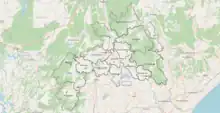Parvathipuram Manyam district
Manyam district | |
|---|---|
     Kamalingeshwara Temple in Gallavilli, Pedda Gedda Dam, Teak plantations near Salur, View of Eastern Ghats from Parvathipuram, View near Palakonda | |
.svg.png.webp) Parvathipuram Manyam district in Andhra Pradesh | |
Interactive map outlining district | |
| Coordinates: 18°48′N 83°24′E / 18.8°N 83.4°E | |
| Country | |
| State | Andhra Pradesh |
| Region | Uttarandhra |
| Headquarters | Parvathipuram |
| Largest city | Parvathipuram |
| Government | |
| • District collector | Sri. Nishant Kumar, I.A.S. Collector & District Magistrate |
| • Lok Sabha constituencies | Araku |
| • Assembly constituencies | 04 |
| Area | |
| • Total | 3,659 km2 (1,413 sq mi) |
| Population | |
| • Total | 925,340 |
| • Density | 250/km2 (650/sq mi) |
| • Urban | 124,104 |
| Time zone | UTC+05:30 (IST) |
| Website | parvathipurammanyam |
Parvathipuram Manyam district is a district in the Indian state of Andhra Pradesh. With Parvathipuram as its administrative headquarters, it became functional from 4th April 2022. The district was formed from Parvathipuram revenue division from Vizianagaram district and part of Palakonda revenue division of Srikakulam district.[3][4][5][6] The district was once part of ancient Kalinga. The famous Kamalingeswara swamy temple was built in the regin of King Rajaraja Deva of Eastern Ganga Dynasty of Odisha in 11th century CE.[7][8]
Geography
This district is located between Northern latitude of 18.8, Eastern longitude of 83.4. This district is bounded by North of Koraput district of Odisha state And surrounded by South of Vizianagaram district, Srikakulam district and west of Alluri Sitharama Raju district and east of Rayagada district of Odisha state .
Politics
There are one parliamentary and 4 assembly constituencies in Parvathipuram Manyam district. The parliamentary constituencies are
The assembly constituencies are[9]
| Constituency number | Name | Reserved for (SC/ST/None) |
Lok Sabha constituency |
|---|---|---|---|
| 10 | Parvathipuram | SC | Araku |
| 11 | Palakonda | ST | |
| 12 | Kurupam | ST | |
| 13 | Salur | ST |
Administrative divisions

The district is divided into 2 revenue divisions: Palakonda and Parvathipuram, which are further subdivided into a total of 26 mandals, each headed by a sub-collector.[10]
Mandals
The list of 26 mandals in Krishna district, divided into 3 revenue divisions, is given below.
- Palakonda revenue division
- Jiyyammavalasa
- Gummalaxmipuram
- Kurupam
- Palakonda
- Seethampeta
- Bhamini
- Veeraghattam
- Parvathipuram revenue division
- Parvathipuram
- Seethanagaram
- Balijipeta
- Salur
- Panchipenta
- Makkuva
- Komarada
- Garugubilli
Cities and towns
| Rank | Division | Pop. | |||||||
|---|---|---|---|---|---|---|---|---|---|
| 1 | Parvathipuram | Parvathipuram Division | 53,844 | ||||||
| 2 | Salur | Parvathipuram Division | 49,500 | ||||||
| 3 | Palakonda | Palakonda Division | 20,760 | ||||||
| 4 | [[{{{city_4}}}]] | [[{{{div_4}}}]] | {{{pop_4}}} | ||||||
| 5 | [[{{{city_5}}}]] | [[{{{div_5}}}]] | {{{pop_5}}} | ||||||
| 6 | [[{{{city_6}}}]] | [[{{{div_6}}}]] | {{{pop_6}}} | ||||||
| 7 | [[{{{city_7}}}]] | [[{{{div_7}}}]] | {{{pop_7}}} | ||||||
| 8 | [[{{{city_8}}}]] | [[{{{div_8}}}]] | {{{pop_8}}} | ||||||
| 9 | [[{{{city_9}}}]] | [[{{{div_9}}}]] | {{{pop_9}}} | ||||||
| 10 | [[{{{city_10}}}]] | [[{{{div_10}}}]] | {{{pop_10}}} | ||||||
Demographics
At the time of the 2011 census the district had a population of 9,25,340, of which 124,104 (13.41%) live in urban areas. Parvathipuram Manyam district has a sex ratio of 1035 females per 1000 males and a literacy rate of 50.90%. Scheduled Castes and Scheduled Tribes make up 1,10,169 (11.91%) and 2,60,419 (28.14%) of the population respectively.[1][2]
At the time of the 2011 census, 89.00% of the population spoke Telugu, 5.86% Sora and 2.15% Kuvi as their first language.[12]
References
- 1 2 "District Census Hand Book – Srikakulam" (PDF). Census of India. Registrar General and Census Commissioner of India.
- 1 2 "District Census Hand Book – Vizianagaram" (PDF). Census of India. Registrar General and Census Commissioner of India.
- ↑ Raghavendra, V. (26 January 2022). "With creation of 13 new districts, AP now has 26 districts". The Hindu. ISSN 0971-751X. Archived from the original on 26 January 2022. Retrieved 26 January 2022.
- ↑ "AP issues draft gazette notification on 26 districts". Deccan Chronicle. 26 January 2022. Archived from the original on 29 January 2022. Retrieved 11 February 2022.
- ↑ "New districts to come into force on April 4". The Hindu. 30 March 2022. Archived from the original on 31 March 2022. Retrieved 31 March 2022.
- ↑ "కొత్త జిల్లా తాజా స్వరూపం". Eenadu.net (in Telugu). 31 March 2022. Retrieved 31 March 2022.
- ↑ Rajguru, Padmashri Dr. Satyanarayana (1960). "No 1 - Gallavalli CP grant of Devendra Varma Rajaraja". Inscriptions of Orissa. Vol. 3 - Part I. Bhubaneswar, Odisha: Odisha State Museum. p. 23.
- ↑ Rajguru, Padmashri Dr. Satyanarayana (1960). "No 1 - Gallavalli plates of Manujendravarman,son of Devendra Varman". Inscriptions of Orissa. Vol. 2. Bhubaneswar, Odisha: Odisha State Museum. p. 206.
- ↑ "District-wise Assembly-Constituencies". ceoandhra.nic.in.
- ↑ "New AP Map: Check Out Biggest and Smallest Districts in Andhra Pradesh". Sakshi Post. 3 April 2022. Retrieved 4 May 2022.
- ↑ "Population by Religion - Andhra Pradesh". censusindia.gov.in. Registrar General and Census Commissioner of India. 2011.
- 1 2 "Table C-16 Population by Mother Tongue: Andhra Pradesh". Census of India. Registrar General and Census Commissioner of India.